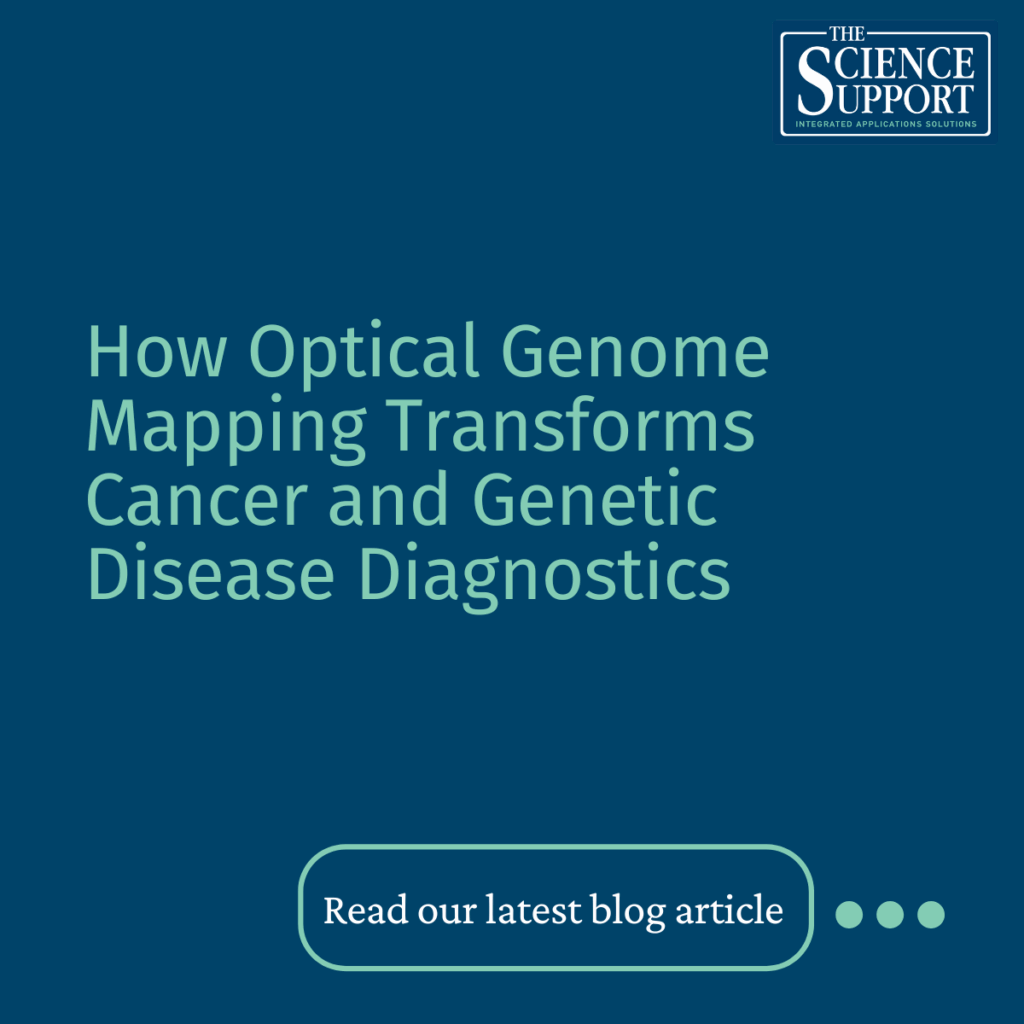Optical Genome Mapping (OGM) is revolutionizing how laboratories detect structural variations (SVs) in genomic DNA. Unlike traditional cytogenetic techniques, OGM offers a high-throughput, label-free approach to identify complex genomic rearrangements that often go undetected by sequencing-based methods. It is a powerful tool that brings unparalleled resolution, accuracy, and efficiency to cancer and rare disease diagnostics.
In this article, we explore how OGM works, its impact on genetic diagnostics, and how laboratories can integrate OGM into their workflows with support from The Science Support and our trusted network of partners.
What is Optical Genome Mapping?
Optical Genome Mapping is a next-generation genomic analysis method that enables high-resolution, long-range detection of structural variants by imaging ultra-long, fluorescently labeled DNA molecules. This technology excels in identifying:
- Insertions and deletions (indels)
- Translocations
- Inversions
- Copy number variations (CNVs)
- Repeat expansions and contractions
Unlike short-read sequencing, which can miss large and complex rearrangements, OGM allows direct visualization of genome architecture at the megabase scale, making it ideal for applications in cancer genomics, rare genetic disorders, and constitutional chromosomal abnormalities.
Why Structural Variants Matter in Cancer and Genetic Disease
Structural variants are a major cause of genetic disease and cancer, accounting for up to 40% of pathogenic variants in some studies. Yet, conventional methods such as karyotyping, FISH, or chromosomal microarrays (CMA) often miss these rearrangements due to their limited resolution or the need for targeted probes.
OGM overcomes these challenges by offering unbiased, genome-wide detection, single-molecule resolution, rapid turnaround time, and the possibility of integrating with bioinformatics platforms for variant interpretation.
According to recent studies, Optical Genome Mapping has identified previously undetectable SVs in leukemias, solid tumors, and neurodevelopmental disorders, leading to more precise diagnoses and treatment strategies (Mantere, 2021).
Applications in Clinical Genomics
OGM is being rapidly adopted in both research and clinical labs for:
Hematological malignancies
- Detection of gene fusions and translocations (e.g., BCR-ABL1, KMT2A rearrangements)
- Improved cytogenetic characterization for risk stratification
Rare genetic disorders
- Accurate diagnosis of neurodevelopmental diseases, syndromes, and chromosomal abnormalities
- Identification of de novo SVs in trios
Solid tumor analysis
- Mapping complex rearrangements in breast, prostate, and brain cancers
- Differentiation of subclonal tumor populations
Integrating OGM into the Lab Workflow
At The Science Support, we provide end-to-end assistance to laboratories ready to integrate Optical Genome Mapping into their genomics platforms. Our services and solutions cover:
- Supply, installation, maintenance and refurbishment of instrumentation: We work with leading technology providers to supply validated OGM platforms capable of high-throughput imaging and data capture of ultra-long DNA molecules.
- Sample preparation kits: From high-molecular-weight DNA extraction to fluorescent labeling, we provide reagent kits that ensure optimal DNA quality and reproducibility — a critical step for successful genome mapping.
- Bioinformatics and data analysis: We take on the software and network installation and upgrades, integration with advanced software to enable the analysis of SVs with intuitive visualization tools, clinical annotation databases, and customizable reporting features.
- Personalized consultation and technical training
- Local support and troubleshooting tailored to your needs.
Explore our genomic solutions here or contact our team at sales@thesciencesupport.com.
References:
Mantere, T. e. (2021). Optical genome mapping enables constitutional chromosomal aberration detection. American Journal of Human Genetics, 108(8), 1409-1422. doi:10.1016/j.ajhg.2021.05.012



